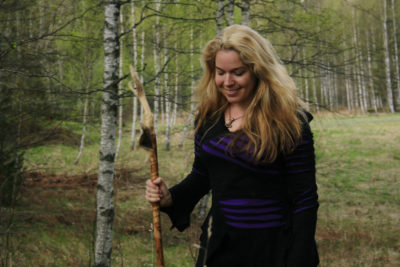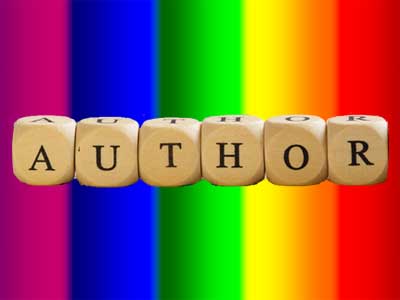
Dr. Maria Kvilhaug is a Norwegian author and historian who writes in the English language. She was born in Oslo, Norway, in 1975. She has written both fiction and non-fiction centering on the pre-Christian culture of Scandinavia, particularly the Viking Age and the early Medieval period. She studied History of Religions, History, Philosophy and Old Norse Philology (the study and interpretation of ancient languages) at the University of Oslo, graduating with an MA degree in 2004; The Maiden with the Mead – a Goddess of Initiation Rituals in Old Norse Mythology.
Between 2009-2013, Kvilhaug published a series of lecture videos on YouTube discussing, mainly, the meaning of metaphors in Old Norse myths. The interest she received spurred her into writing a book about the same theme; The Seed of Yggdrasill. Since then, Kvilhaug has published four fiction novels in the same series (Blade Honer), exploring the early life of the youngest Oseberg woman, as well as two non-fiction books with translations and commentaries of original Norse texts on mythology and poetry.
Maria grew up in Norway, but as a young adult lived several years abroad; in England (London & Stoke-On-Trent), in the USA (Caliphornia; Berkeley and Oakland), Mexico (Oaxaca) and Portugal (Arganil). She has published with VDM Verlag, Whyte Tracks, Createspace, KDP and, finally, the Saga Press. She works part time as a health and care worker. She lives with her man and her cat at the edge of a forest in what used to be old Vingulmark. She adheres to no particular religion, but takes a non-dogmatic, spiritual, mystical as well as an academic and scientific approach to both life and her own work, and sees no problem with combining these.
“The poets who created the myths as we know them were taught to reveal deep spiritual meanings through metaphors, or, as Snorri put it, they were taught to understand that which was subtly sung and hidden in symbols. What is revealed in the Edda is a spiritual path where the illusions of the gods are destroyed to reveal an even greater reality behind them. The Edda poems may not be representative of the lost common folk beliefs in Pagan times, but they certainly represent an ancient lore of spiritual and metaphysical mysteries, an outright philosophy, that in certain aspects is even sometimes close to what we today know as science.”
Maria Kvilhaug, The Seed of Yggdrasill
Blog/Website, YouTube, Facebook, Amazon (USA), Main Publisher from 2020
Published books (titles and links)
- The Maiden with the Mead – A Goddess of Initiation in Old Norse Myths? (2004: University of Oslo, 2009: VDM Verlag). Read for free.
- The Seed of Yggdrasill – Deciphering the Hidden Messages of Old Norse Mythology (2013) is currently out of print but will be republished in the autumn of 2020 by The Three Little Sisters
- Blade Honer – Historical Novel Series (Life of the Oseberg Priestess)
- The Hammer of Greatness (2014)
- My Enemy’ Head (2015)
- The Hel Rune’s Claim (2016)
- A Twisted Mirror (2018)
The first three novels will be republished in the autumn of 2020 by The Three Little Sisters and are otherwise available at Amazon in most countries.
- The Poetic Edda – Six Cosmology Poems (2017)
- “The Trickster and the Thundergod – Thor and Loki in Old Norse Myths” (2018)
List of published works (more information on each)
“The Maiden with the Mead – A Goddess of Initiation Rituals in Old Norse Mythology?” This is her University Master dissertation of 2004, proving that several Edda poems follow the same structure and themes of initiation similar to shamanic and even more particularly to Classical Mystery religions. It was published as a book by VDM Verlag in 2009. However, the raw thesis may be read online for free at the University of Oslo library
“The Seed of Yggdrasill – Deciphering the Hidden Messages in Old Norse Myths” was first published by Whyte Tracks Inc. in 2013-2019. It is a work about the use of metaphors in the mythical Edda poetry and how to decipher them in order to understand the meanings that the poets were trying to convey. In this work, Kvilhaug takes the consistent use of meaningful heiti (nicknames) and kenningar (metaphors) in Old Norse poetry seriously and considers the mythical poems in the light of three major influences she believes can be detected in these poems; 1) the Medieval tradition of Integumenta (an understanding of pagan myths as basically allegorical, parables about the human condition in a greater cosmos) and 2) the myths of Classical Mystery religions (in which each Classical myth is considered a parable about the human soul´s path towards union with the divine) and 3) the ancient connection between the Norse traditions and the Indo-European ancestors of the Vedic (Indian) and Avestan (Iranian) traditions of a philosophical and metaphysical approach to the universe and the meaning of life expressed through the allegories of myth.
Blade Honer – A Historical Fiction series centered around the life of the youngest woman who was buried in the famous ship grave of Oseberg in Vestfold, Norway, in the year 834 A.D.
- Book One: “The Hammer of Greatness” (2014, Createspace): Born in the Baltic, Thordís is a daughter to the Gaut Thunder priest (Thorsgódi) Thorbjörn, whose lineage was destroyed by the Svear king, forcing Thorbjörn to flee to Aldeigjuborg, the first Viking settlement in Gardaríki (Russia). Another conflict with his own captain leads Thorbjörn to flee into the Baltic river lands during a summer raiding expedition, where he encounters the beautiful Healer and her daughter, Zivah. When Thordís is seven years old and Zivah is seventeen, their peaceful village is raided by Vikings from Aldeigjuborg. Orphaned and alone, Thordís embarks on a powerful quest to save the freedom of her sister and herself, endearing herself to these rogue pirates and securing a place among them.
- Book Two: “My Enemy´s Head” (2014, Createspace): The second book centers around life in the Viking court of Aldeigjuborg with Zivah and Thordís coming to terms with their new situations. Thordís becomes an aspiring shield maiden while learning how to hone boys into men.
- Book Three: “The Hel Rune´s Claim” (2015, Createspace): The third book takes us out of court and into the larger settlement of Aldeigjuborg and their international relations as young Thordís and her friend Ivarr Hallgrimsson learn to know each other and the world around them. Like the second book began to do, this book centers around the great rites of the seasons as well as marriage rites.
- Book Four: “A Twisted Mirror” (2017, Createspace): The fourth book describes Thordis´ involuntary apprenticeship to the Hel Runes, priestesses of Death and human sacrifice, her coming of age and her new role as the Vessel of the gods and as a Thunder priestess, reclaiming her father´s legacy.
More books will come eventually….
- “The Poetic Edda – Six Cosmology Poems” (2017, Createspace), a book with translations, interpretations and commentaries to six Edda poems; the Vǫluspá, the Váfþruðnismál, the Grímnismál, Grǫttasǫngr, Allvismál and Hyndlulióð. A valuable companion to The Seed of Yggdrasill although it may be read on its own.
- “The Trickster and the Thundergod – Thor and Loki in Old Norse Myths” (2018, Createspace), a book with translations, interpretations and commentaries to all the Old Norse written material there is about Thor and Loki; here you will get translations with explanations of Skaldic poetry, Edda poetry and prose passages from Snorri´s Edda and Flateyiarbók.
- “Alle netter ni – Mysterier, innvielsesritualer og den hellige drikken i norrøn mytologi” (2018, Createspace) er forfatterens første utgivelse på norsk.
[1]Bron: Maria Kvilhaug

